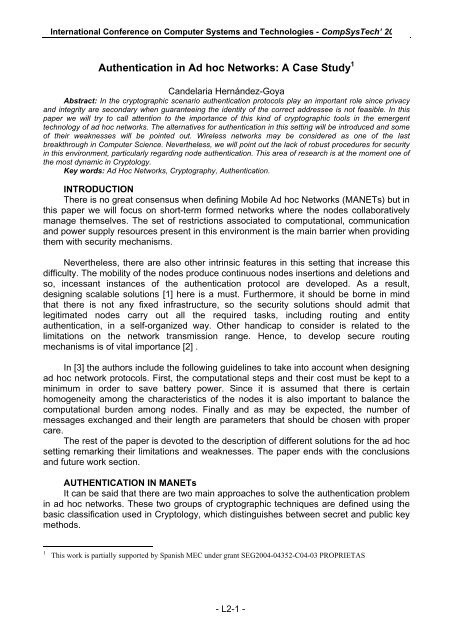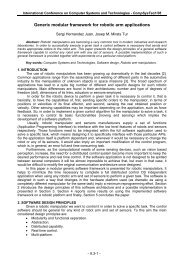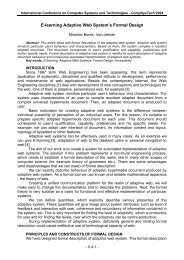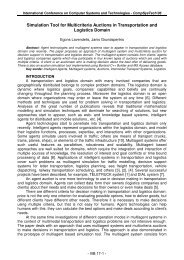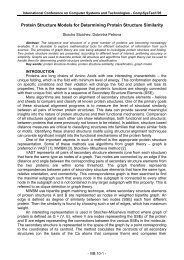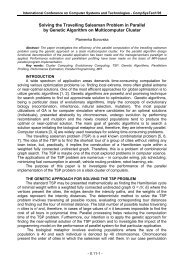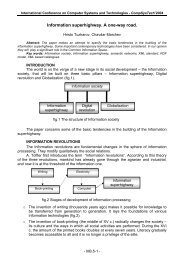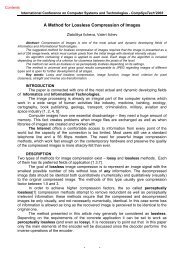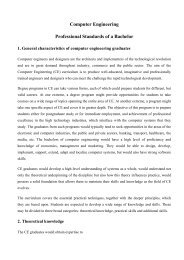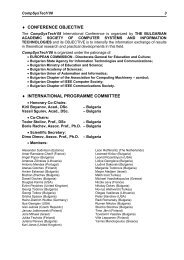Authentication in Ad hoc Networks: A Case Study - Ecet
Authentication in Ad hoc Networks: A Case Study - Ecet
Authentication in Ad hoc Networks: A Case Study - Ecet
You also want an ePaper? Increase the reach of your titles
YUMPU automatically turns print PDFs into web optimized ePapers that Google loves.
International Conference on Computer Systems and Technologies - CompSysTech’ 2005<br />
<strong>Authentication</strong> <strong>in</strong> <strong>Ad</strong> <strong>hoc</strong> <strong>Networks</strong>: A <strong>Case</strong> <strong>Study</strong> 1<br />
Candelaria Hernández-Goya<br />
Abstract: In the cryptographic scenario authentication protocols play an important role s<strong>in</strong>ce privacy<br />
and <strong>in</strong>tegrity are secondary when guarantee<strong>in</strong>g the identity of the correct addressee is not feasible. In this<br />
paper we will try to call attention to the importance of this k<strong>in</strong>d of cryptographic tools <strong>in</strong> the emergent<br />
technology of ad <strong>hoc</strong> networks. The alternatives for authentication <strong>in</strong> this sett<strong>in</strong>g will be <strong>in</strong>troduced and some<br />
of their weaknesses will be po<strong>in</strong>ted out. Wireless networks may be considered as one of the last<br />
breakthrough <strong>in</strong> Computer Science. Nevertheless, we will po<strong>in</strong>t out the lack of robust procedures for security<br />
<strong>in</strong> this environment, particularly regard<strong>in</strong>g node authentication. This area of research is at the moment one of<br />
the most dynamic <strong>in</strong> Cryptology.<br />
Key words: <strong>Ad</strong> Hoc <strong>Networks</strong>, Cryptography, <strong>Authentication</strong>.<br />
INTRODUCTION<br />
There is no great consensus when def<strong>in</strong><strong>in</strong>g Mobile <strong>Ad</strong> <strong>hoc</strong> <strong>Networks</strong> (MANETs) but <strong>in</strong><br />
this paper we will focus on short-term formed networks where the nodes collaboratively<br />
manage themselves. The set of restrictions associated to computational, communication<br />
and power supply resources present <strong>in</strong> this environment is the ma<strong>in</strong> barrier when provid<strong>in</strong>g<br />
them with security mechanisms.<br />
Nevertheless, there are also other <strong>in</strong>tr<strong>in</strong>sic features <strong>in</strong> this sett<strong>in</strong>g that <strong>in</strong>crease this<br />
difficulty. The mobility of the nodes produce cont<strong>in</strong>uous nodes <strong>in</strong>sertions and deletions and<br />
so, <strong>in</strong>cessant <strong>in</strong>stances of the authentication protocol are developed. As a result,<br />
design<strong>in</strong>g scalable solutions [1] here is a must. Furthermore, it should be borne <strong>in</strong> m<strong>in</strong>d<br />
that there is not any fixed <strong>in</strong>frastructure, so the security solutions should admit that<br />
legitimated nodes carry out all the required tasks, <strong>in</strong>clud<strong>in</strong>g rout<strong>in</strong>g and entity<br />
authentication, <strong>in</strong> a self-organized way. Other handicap to consider is related to the<br />
limitations on the network transmission range. Hence, to develop secure rout<strong>in</strong>g<br />
mechanisms is of vital importance [2] .<br />
In [3] the authors <strong>in</strong>clude the follow<strong>in</strong>g guidel<strong>in</strong>es to take <strong>in</strong>to account when design<strong>in</strong>g<br />
ad <strong>hoc</strong> network protocols. First, the computational steps and their cost must be kept to a<br />
m<strong>in</strong>imum <strong>in</strong> order to save battery power. S<strong>in</strong>ce it is assumed that there is certa<strong>in</strong><br />
homogeneity among the characteristics of the nodes it is also important to balance the<br />
computational burden among nodes. F<strong>in</strong>ally and as may be expected, the number of<br />
messages exchanged and their length are parameters that should be chosen with proper<br />
care.<br />
The rest of the paper is devoted to the description of different solutions for the ad <strong>hoc</strong><br />
sett<strong>in</strong>g remark<strong>in</strong>g their limitations and weaknesses. The paper ends with the conclusions<br />
and future work section.<br />
AUTHENTICATION IN MANETs<br />
It can be said that there are two ma<strong>in</strong> approaches to solve the authentication problem<br />
<strong>in</strong> ad <strong>hoc</strong> networks. These two groups of cryptographic techniques are def<strong>in</strong>ed us<strong>in</strong>g the<br />
basic classification used <strong>in</strong> Cryptology, which dist<strong>in</strong>guishes between secret and public key<br />
methods.<br />
1<br />
This work is partially supported by Spanish MEC under grant SEG2004-04352-C04-03 PROPRIETAS<br />
- - L2-1 -
International Conference on Computer Systems and Technologies - CompSysTech’ 2005<br />
The solutions <strong>in</strong>cluded <strong>in</strong> the first group are not many and they are recommended for<br />
sensor networks as the devices form<strong>in</strong>g these networks are even more constra<strong>in</strong>ed <strong>in</strong> their<br />
resources. <strong>Ad</strong>ditionally, the problem of key distribution is difficult to overcome, be<strong>in</strong>g<br />
physical contact the most simple and extended solution [4]. Also, the authentication<br />
scheme implemented <strong>in</strong> the Bluetooth technology fells <strong>in</strong>to the secret key class. Bluetooth<br />
is a short range wireless connectivity standard designed to allow wireless communication<br />
among diverse devices such as mobile phones, Palm, Pocket PC, etc. Here, the<br />
authentication is based on <strong>in</strong>troduc<strong>in</strong>g a PIN <strong>in</strong> the devices and carry out a weak<br />
challenge-response protocol. Then, a shared key of length 128 bits is generated. The<br />
block cipher SAFER+ is used dur<strong>in</strong>g authentication. Nonetheless it is catalogued as a nonscalable<br />
procedure for large environments. At the same time, the fact that only the device<br />
is authenticated but not the user is consider another drawback. The second approach,<br />
methods based on Public Key Infrastructure (PKI), are the most studied so far. The<br />
literature about the subject is ma<strong>in</strong>ly focused on how to use public key cryptography and<br />
how to manage public key certificates <strong>in</strong> this restricted ambience [5] [6, 7].<br />
Among the available possibilities to implement PKI <strong>in</strong> ad <strong>hoc</strong> networks, the easiest<br />
way is to employ a globally trusted centralized Certification Authority (CA). Nevertheless,<br />
this approximation should be discarded as it will h<strong>in</strong>der scalability. The ma<strong>in</strong> obstacle is<br />
that the access to this entity may provoke a bottleneck, slow<strong>in</strong>g down the communications<br />
among member of the network s<strong>in</strong>ce it is compulsory connect<strong>in</strong>g with the CA each time<br />
that to verify a certificate is needed. Jo<strong>in</strong>tly with the previous reasons, it should be<br />
considered the fact that hav<strong>in</strong>g the certification service centralized may produce that the<br />
deployment of DoS attacks will be more effective and attractive. Mention should also be<br />
made of the complexity added to the rout<strong>in</strong>g process <strong>in</strong> the presence of this entity.<br />
All th<strong>in</strong>gs considered then, the most natural modification is to distribute the CA task<br />
among a set of nodes. In this sense, <strong>in</strong> [8] the authors put forward that the CA’s functions<br />
will be developed by a set of special servers <strong>in</strong>cluded <strong>in</strong> the network. These servers will<br />
sign the public key of the nodes trough a (t,n) threshold signature scheme [9]. In this way,<br />
each time a component of the network B wishes to communicate with one of his peers A,<br />
he should contact with t+1 servers <strong>in</strong> advance <strong>in</strong> order to obta<strong>in</strong> A’s public key signed with<br />
the CA’s secret key. In this proposal, the signature of the requested public key is<br />
generated by one of the servers <strong>in</strong>volved <strong>in</strong> the previously mentioned coalition, play<strong>in</strong>g the<br />
comb<strong>in</strong>er’s role. However, some difficulties still exist. First, the comb<strong>in</strong>er figure and the<br />
servers act<strong>in</strong>g as certification authorities produce system congestion as all the requests<br />
should be attended for them. <strong>Ad</strong>ditionally, <strong>in</strong>troduc<strong>in</strong>g special servers does not guarantee<br />
the eradication of vulnerabilities to DoS attacks. As for the storage requirements, it should<br />
be po<strong>in</strong>ted out that the public keys of all the members of the network must be stored by the<br />
servers, which entail considerable memory needs. Another handicap to be faced by any<br />
user is the need to have t + 1 servers available <strong>in</strong> its transmission range. Apart from the<br />
aforementioned h<strong>in</strong>drance, the explanation of how the users are authenticated by the<br />
servers for the first time is not tackled <strong>in</strong> the paper.<br />
The methods <strong>in</strong>cluded <strong>in</strong> [10] and [1] solve some of the preced<strong>in</strong>g problems through<br />
the removal of the servers. In both, any group of t+1 nodes without dist<strong>in</strong>ction may act as<br />
servers at the moment of issu<strong>in</strong>g certificates. Consequently, one of the mayor advantages<br />
of this strategy is the balance <strong>in</strong> the distribution of the computational load among nodes.<br />
Although this characteristic has particular significance <strong>in</strong> MANETs, a number of remarks<br />
need to be made. Firstly, a distributor <strong>in</strong> charge of provid<strong>in</strong>g credentials to the first nodes<br />
- - L2-2 -
International Conference on Computer Systems and Technologies - CompSysTech’ 2005<br />
should be considered dur<strong>in</strong>g the bootstrapp<strong>in</strong>g stage. Secondly, f<strong>in</strong>d<strong>in</strong>g a valid coalition<br />
each time a certificate needs to be verified may result <strong>in</strong>feasible depend<strong>in</strong>g on the network<br />
actual topology and conditions. Besides, the methods <strong>in</strong> [10] do not provide any <strong>in</strong>strument<br />
to protect aga<strong>in</strong>st malicious nodes when they send fakes shares.<br />
A third alternative implementation of PKI was outl<strong>in</strong>ed <strong>in</strong> [7]. Here the authors deploy<br />
pr<strong>in</strong>ciples similar to the ones used by PGP. In this framework, each node B may sign the<br />
certificates associated to those peers with whom orig<strong>in</strong>ally he share a trust relationship.<br />
From here on, each node generates a certificate repository that is merged with the<br />
repository correspond<strong>in</strong>g to its neighbours when the authentication <strong>in</strong>volves a user whose<br />
credentials are not <strong>in</strong>cluded <strong>in</strong> B’s repository. This comb<strong>in</strong>ation will form trust cha<strong>in</strong>s<br />
among nodes <strong>in</strong> order to validate the public key. All this procedures are described us<strong>in</strong>g<br />
what the authors call certificate graph as model enabl<strong>in</strong>g <strong>in</strong> this way the use of graph<br />
algorithm <strong>in</strong> the construction of optimal trust cha<strong>in</strong>s.<br />
To some extent it is true to say that it can be stated that this solution is the most<br />
robust so far, but there were factors which arguably may be considered as limitations. A<br />
first <strong>in</strong>convenience regards the certificate repositories, their construction is not efficient,<br />
and they are expensive to create. As we have po<strong>in</strong>ted out, the verification tasks are more<br />
complicated than the ones carried out <strong>in</strong> other approaches. On the other hand, when the<br />
community where the method is applied is limited (allow<strong>in</strong>g to guarantee the truest<br />
relationships), this alternative turns out to be viable.<br />
The proposal presented at [11] also makes use of PKI. The <strong>in</strong>novation is that the<br />
network is divided <strong>in</strong>to trusted subgroup (members of the same group trust each other)<br />
and members of the same group share a pair of keys. A different key pair is shared among<br />
all the members of the network. In order to accomplish the authentication, it is essential<br />
the existence of a head group with greater computational capacities. Once more, it is<br />
considered a negative aspect s<strong>in</strong>ce aga<strong>in</strong> it will produce an imbalance <strong>in</strong> the computational<br />
load of the nodes.<br />
Assum<strong>in</strong>g that the major deterrent regard<strong>in</strong>g the use of PKI <strong>in</strong> ad <strong>hoc</strong> networks is<br />
certificate management, there are some works [12] where the use of PKI without us<strong>in</strong>g<br />
certificates is v<strong>in</strong>dicate. So as to achieve it the public key of all the nodes <strong>in</strong>volved should<br />
be exchanged through a location-limited channel, solution that is only applicable <strong>in</strong> small<br />
networks.<br />
Given that none of the mentioned solution has been satisfactory, it is logical to th<strong>in</strong>k<br />
of hybrid methods where symmetric and asymmetric tools are comb<strong>in</strong>ed. An<br />
exemplification of these methods may be found <strong>in</strong> [13, 14]. In this work, a protocol based<br />
on passwords is presented. Unfortunately, the operations to develop <strong>in</strong> this protocol are<br />
too heavy to be implemented <strong>in</strong> ad <strong>hoc</strong> networks.<br />
After analyz<strong>in</strong>g the authentication procedure proposed to date for MANETs, it can be<br />
deduced that the central barriers that still have not been solved are the follow<strong>in</strong>g:<br />
• Certa<strong>in</strong> <strong>in</strong>frastructure is required <strong>in</strong> order to support the certificates associated to the<br />
nodes.<br />
• The computational requirements are <strong>in</strong> general considerable.<br />
- - L2-3 -
International Conference on Computer Systems and Technologies - CompSysTech’ 2005<br />
• When an adversary is able to control a determ<strong>in</strong>ed subset of nodes, the network is<br />
completely compromised.<br />
• The reauthentication processes are almost as expensive as beg<strong>in</strong>n<strong>in</strong>g the<br />
authentication aga<strong>in</strong>.<br />
Try<strong>in</strong>g to avoid these difficulties the use of advanced protocols such as Zero<br />
Knowledge Interactive Proofs is advisable. The application of these protocols <strong>in</strong> MANETs<br />
is still a novel research area, and it is considered as a promis<strong>in</strong>g one [15], [11], [16].<br />
Nevertheless, there are no new published proposals specifically designed for this<br />
framework hitherto.<br />
CONCLUSIONS AND FUTURE WORK<br />
After the journey through authentication protocols and focus<strong>in</strong>g <strong>in</strong> our case study: ad <strong>hoc</strong><br />
networks, we found that there is not a satisfactory solution yet. More work is needed to<br />
address the problem of admission control <strong>in</strong> peer groups as well as <strong>in</strong> the design of<br />
advanced and low-cost protocols.<br />
REFERENCES<br />
1. Haiyun, L., et al. Self-Secur<strong>in</strong>g <strong>Ad</strong> Hoc Wireless <strong>Networks</strong>. <strong>in</strong> Proceed<strong>in</strong>gs of the Seventh<br />
IEEE Symposium on Computers and Communications (ISCC '02). 2002.<br />
2. Royer, E. and Toth, C.K., A Review of Current Rout<strong>in</strong>g Protocols for <strong>Ad</strong> Hoc Mobile<br />
Wireless <strong>Networks</strong>. IEEE Personal Communications Magaz<strong>in</strong>e, 1999: p. 46-55.<br />
3. Hoeper, K. and G. Gong, Models of <strong>Authentication</strong>s <strong>in</strong> <strong>Ad</strong> Hoc <strong>Networks</strong> and Their Related<br />
Network Properties. 2004.<br />
4. Stajano, F. and Anderson. R., The Resurrect<strong>in</strong>g Duckl<strong>in</strong>g: Security Issues for <strong>Ad</strong>-Hoc<br />
Wireless <strong>Networks</strong>. <strong>in</strong> Proceed<strong>in</strong>gs of the 7th International Workshop on Security Protocols.<br />
1999.<br />
5. Luo, H. and Lu, S., Ubiquitous and Robust <strong>Authentication</strong> Services for <strong>Ad</strong> Hoc Wireless<br />
<strong>Networks</strong>. 2000.<br />
6. Capkun, S., Buttyan, L. and Hubaux, J.P., Self-Organized Public-Key Management for<br />
Mobile <strong>Ad</strong>-Hoc <strong>Networks</strong>. In IEEE Transactions on Mobile Comput<strong>in</strong>g, 2003.<br />
7. Capkun, S., Buttyan, L., and Hubaux, J.P., Self-Organized Public-Key Management for<br />
Mobile <strong>Ad</strong>-Hoc <strong>Networks</strong>. 2003.<br />
8. Zhou, L. and Haas, Z., Secur<strong>in</strong>g <strong>Ad</strong> Hoc <strong>Networks</strong>. IEEE <strong>Networks</strong>, 1999. 13: p. 24--30.<br />
9. R.Gennaro, et al., Robust threshold {DSS} signatures. <strong>Ad</strong>vances <strong>in</strong> Cryptology - EuroCrypt<br />
'96, ed. M. Ueli. 1996, Berl<strong>in</strong>. 354--371.<br />
10. Kong, H., et al., Provid<strong>in</strong>g Robust and Ubiquitous Security Support for Mobile <strong>Ad</strong>-Hoc<br />
<strong>Networks</strong>, <strong>in</strong> International Conference on Network Protocols (ICNP). 2001. p. 251-260.<br />
11. Sankar, K., Secur<strong>in</strong>g <strong>Authentication</strong> and Privacy <strong>in</strong> <strong>Ad</strong> Hoc Partitioned <strong>Networks</strong>.<br />
Symposium on Applications and the Internet Workshops {(SAINT'03} Workshops). 2003,<br />
Orlando, Florida. 354.<br />
12. Balfanz, D., et al., Talk<strong>in</strong>g To Strangers: <strong>Authentication</strong> <strong>in</strong> <strong>Ad</strong>-Hoc Wireless <strong>Networks</strong>. In<br />
Symposium on Network and Distributed Systems Security {(NDSS} '02). 2002, San Diego,<br />
California.<br />
13. Kam<strong>in</strong>sky, A., Infrastructure for Distributed Applications <strong>in</strong> <strong>Ad</strong> Hoc <strong>Networks</strong> of Small<br />
Mobile Wireless Devices. 2001.<br />
14. Jonathan, K., Rafail, O. and Moti, Y., Efficient Password-Authenticated Key Exchange<br />
Us<strong>in</strong>g Human-Memorable Passwords. <strong>Ad</strong>vances <strong>in</strong> Cryptology - EUROCRYPT 2001.<br />
2001.<br />
- - L2-4 -
International Conference on Computer Systems and Technologies - CompSysTech’ 2005<br />
15. Alan, K., Infrastructure for Distributed Applications <strong>in</strong> <strong>Ad</strong> Hoc <strong>Networks</strong> of Small Mobile<br />
Wireless Devices. 2001.<br />
16. Pirzada, A.A. and McDonald, C., Establish<strong>in</strong>g Trust In Pure <strong>Ad</strong>-Hoc <strong>Networks</strong>. 27th<br />
Australasian Computer Science Conference, Volume 26, ed. V. Estivill-Castro. 2004,<br />
Duned<strong>in</strong>, New Zealand. 47 - 54.<br />
ABOUT THE AUTHORS<br />
Assoc. Lecturer. Candelaria Hernández-Goya, PhD, Department of Statistics, O.R. and<br />
Comput<strong>in</strong>g, Universidad de La Laguna, Phone: +34 922 318 637, -mail: mchgoya@ull.es<br />
- - L2-5 -


